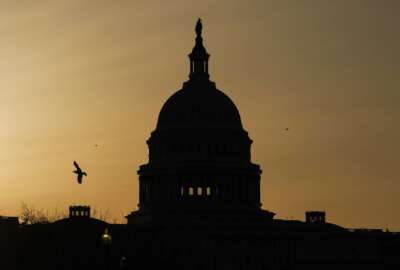Well, we made it through. This time, anyway.
Within the span of 24 hours, House leadership agreed on a deal for a continuing resolution, and members cleared it through the House and Senate after days of drama and disagreement.
President Joe Biden had a whole day to sign it into law before the government shutdown deadline was due to expire.
The CR extends current funding levels through Feb. 18, a date we hadn’t really heard about until Thursday morning, when House appropriators announced a breakthrough deal.
I have to say it looked a little dicey there for a day or so. A small group of senators wanted to hold up passage of a temporary stop-gap over their demands that a CR include a prohibition on funding for the Biden administration’s various vaccine mandates. They agreed to separate vaccine mandate issues into a separate amendment, which failed on the Senate floor on Thursday night.
Senators eventually voted 69-28 to advance the continuing resolution. In today’s world, that’s a landslide.
This might sound like good news. Of course, avoiding a government shutdown is a good thing.
But agency program managers, the Biden administration and most federal contractors will tell you the situation isn’t ideal, especially the longer the CR cycle continues. Prudent members of the opposing party will agree continuing resolutions are always bad news, because they make things more difficult for agencies who, inevitably, have ever-changing priorities that need funding — or at least a need to move funds around.
So what does the continuing resolution mean for the prospects of a federal pay raise at the start of 2022?
As far as we know, the Biden administration is still pressing ahead with its plans to provide a 2.7% federal pay raise to civilian employees starting in January 2022.
(As a reminder, 2.7% is an average. Some employees, depending on their locality pay area, might see raises that slip a notch or two above 2.7%, while others might see raises that are slightly lower).
It’s not official, and it’s not a done deal until it is. That won’t happen until Biden signs an executive order implementing the raise, something that usually happens near the end of the calendar year.
But because agencies are still operating within 2021 funding levels, it means they’ll have to incorporate a pay raise within the bounds of their existing budgets. That means budgets will get tighter for agencies, at least until the point lawmakers pass new appropriations bills for 2022.
If they do at all.
This certainly isn’t the first time in recent memory that agencies will start a new calendar year under a continuing resolution.
It happened back in fiscal 2018, when Congress kept most agencies running on 2017 funding levels through March 2018.
Still, employees got an average 1.9% federal pay raise to start off 2018. Former President Donald Trump made the raise official via an executive order, which he signed in the final days of 2017. Congress eventually signed an omnibus spending bill into law on March 23, 2018.
And who can forget the mess that was fiscal 2019? Congress secured full-year funding for some agencies back in 2018 but left a decent chunk of government operating under a continuing resolution until late December. A partial government shutdown started right around Christmas. As if anyone needed a reminder, it lasted 35 days, the longest in U.S. history.
Another continuing resolution reopened government in late January 2019. Congress eventually passed an omnibus spending bill in mid February, which funded agencies with new spending levels for the remaining months of fiscal 2019.
That bill, which Trump signed on Feb. 15, 2019, included a 1.9% retroactive federal pay raise for civilian employees, a reversal from the pay freeze workers had started the calendar year with.
I mention these examples because we often look for precedents in this space, some indication from the past that might tell us what to expect in the here and now.
But while feds will avoid the kind of government shutdown drama we’ve experienced around the holidays for the last several years now, there’s still plenty for Congress to do.
It must still address the debt ceiling, and the House-passed Build Back Better Act has an uncertain fate. The annual defense authorization is up in the air too. Congress has passed a version of the National Defense Authorization Act for the last six decades.
And once lawmakers return to Capitol Hill from the holidays, they have quite a bit of work ahead of them on those 2022 spending bills. The White House has been warning Congress against the prospects of a full-year continuing resolution, which is still a possibility if members can’t agree on how to fund the Biden administration’s priorities beyond February.
So consider the next several months unsettled, even if you might see a bump in next year’s paychecks.
Nearly Useless Factoid
By David Thornton
Over several months spanning 2011 and 2012, the International Strategic Maple Syrup Reserve in Quebec, Canada, was robbed. Thieves stole 3,000 tonnes of maple syrup, valued at the time at C$18.7 million. Adjusted for inflation, this was the most valuable heist in Canadian history.
Source: Wikipedia
Copyright
© 2024 Federal News Network. All rights reserved. This website is not intended for users located within the European Economic Area.
